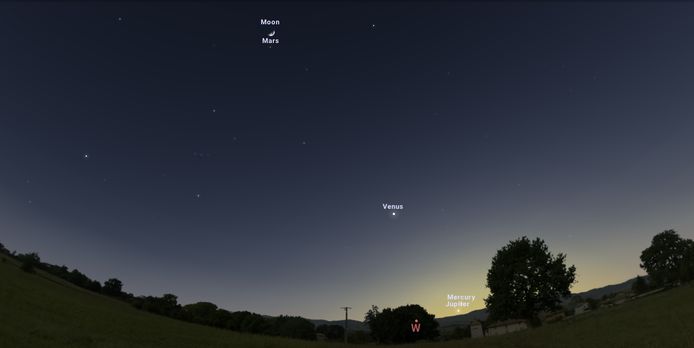Today, Tuesday, March 28th, you can see something exceptional in the sky. Just after sunset, no fewer than five planets can be seen. Your chance to see Jupiter, Mercury, Venus, Uranus and Mars at the same time. But when exactly should you look up and in what direction?
Usually, planets are scattered across the night sky and are visible at different times. But sometimes they are close to each other at the same time. Then they appear to be almost in a straight line, planetary alignment. Basically, this is an optical illusion. All planets revolve in the same plane (almost) around the sun. Because of this, they all follow the annual path that our Sun takes in the sky. This line is called the ecliptic. In fact, the planets are not at all close to each other in space. Currently, Jupiter and Mercury are close to each other, but the average distance between the two planets is 720 million km.
(Continue reading below the image.)

Tonight we can observe such a planetary alignment. You can see five of the eight planets of our solar system at the same time. They are Jupiter, Mercury, Venus, Uranus and Mars on an imaginary line. This sparks great enthusiasm among stargazers around the world, including former Apollo astronaut Buzz Aldrin. He posted the following tweet in anticipation of our planetary neighbors: “I am always looking for great stargazing opportunities… and Tuesday could be a night to grab your binoculars and catch a glimpse of a rather rare alignment of the five planets Mercury, Jupiter, Venus, Uranus, and Mars. Let’s just hope the sky stays clear Clear! “
Where and when can you look at the planetary alignment?
To see the five planets in a row, look to the west just after sunset. You have very little time, because Jupiter and Mercury will soon disappear behind the horizon along with the Sun. During twilight, Jupiter is closest to the horizon. It is also the brighter of the two and is easily visible to the naked eye. Mercury is located very close to Jupiter, which is somewhat more difficult to see with the naked eye (but not impossible) and can certainly be seen with binoculars.
(Continue reading below the image.)

A little higher in the sky you can spot Venus. This bright planet is easy to see without tools. Near the fourth planet, Uranus. This is the only one of the five that you cannot see without binoculars or a telescope. Venus and Uranus also disappear behind the horizon a few hours after sunset. Finally, there is Mars, which sits next to the crescent moon. So you should be able to see at least three of the projectors (Jupiter, Venus and Mars) and maybe even a fourth (Mercury) with just your eyes.
(Continue reading below the image.)


If you want to identify the five planets, look west with binoculars just after sunset at a place where you have a clear view of the horizon. You can also observe the alignment of the planets in the coming days, until Jupiter finally disappears behind the horizon.
Unlimited free access to Showbytes? Which can!
Log in or create an account and never miss a thing from the stars.

“Total coffee specialist. Hardcore reader. Incurable music scholar. Web guru. Freelance troublemaker. Problem solver. Travel trailblazer.”







More Stories
GALA lacks a chapter on e-health
Weird beer can taste really good.
Planets contain much more water than previously thought